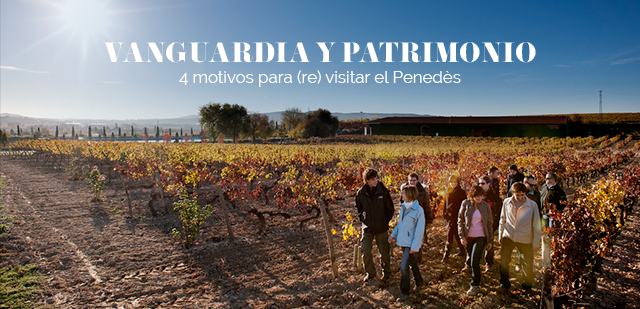HERITAGE MEETS MODERNITY

The history of the Penedès region has been shaped by events that make it a hub of continuous transformation and reinvention. Sometimes this was prompted by necessity, but often the driving force was the innovative spirit of men and women who left their mark on our vineyards and the wine world at large.
“Perhaps no other wine region in Europe has been as effective in its renewal and progress as Penedès has in the last two decades of the 20th century.”
Mauricio Wiesenthal (Diccionario Salvat del Vino, ed. Salvat)
Drawing on its heritage to articulate the reasons for (re)visiting the Penedès region, we would have to include, at the very least, the four listed below:
1. Progress and new blood
The Dutch embargo on French wines during the 17th century brought about a winegrowing revolution in Penedès. The region's production of white wines aimed at the distillation market grew exponentially to meet new demand.
This situation came to a halt with the outbreak of phylloxera in the 19th century. The region's wineries and winegrowers did not, however, seize the opportunity to restructure their vineyards and winemaking approach. Instead, Spain's neutrality during World War I meant that they resumed bulk wine production to satisfy the demand that the French could not.
It wasn't until the 1970s that new names appeared on the scene (Jean Leon, Miguel A. Torres, the Raventós and Ferrer families), introducing a new vision for the production of quality wines. They restored the varietal diversity of the vineyards, modernized production methods and invested in top-quality vineyards and estates. This changed everything.
[[{"fid":"11277","view_mode":"default","fields":{"format":"default","field_file_image_alt_text[und][0][value]":false,"field_file_image_title_text[und][0][value]":false},"type":"media","link_text":null,"attributes":{"height":757,"width":1145,"style":"width: 600px; height: 397px;","class":"media-element file-default"}}]]
Mas La Plana, one of the first Cabernet Sauvignon vineyards
2. Winemakers and Growers
The enormous personality (and humanity) of Penedès wines is undoubtedly due to the fact that most of the wineries also own vineyards, a hallmark of the region.
This romantic vision of the winemaking craft makes it possible to accumulate and preserve a vast legacy of knowledge and experience.
As a result, many of the wineries—both big and small, well-known and obscure—boast exemplary facilities that guarantee high quality standards.
[[{"fid":"11278","view_mode":"default","fields":{"format":"default","field_file_image_alt_text[und][0][value]":false,"field_file_image_title_text[und][0][value]":false},"type":"media","link_text":null,"attributes":{"height":765,"width":1152,"style":"width: 500px; height: 332px;","class":"media-element file-default"}}]]
The new Mas La Plana vinification hall
3. Ancestral varieties: squaring the circle
An exceptional climatic context that is home to a myriad varieties makes it possible to square the circle, which shows the cyclical nature of history:
Whereas the 1970s ushered in an era of modernity with the embrace of international varieties by local winemakers, the Penedès region (and especially the Torres family) now seeks wines that express an individual identity by reintroducing pre-phylloxera ancestral varieties. These varieties make it possible to carve out a distinctive quality-oriented niche and establish a renewed spirit that defines the region's wines.
[[{"fid":"11279","view_mode":"default","fields":{"format":"default","field_file_image_alt_text[und][0][value]":false,"field_file_image_title_text[und][0][value]":false},"type":"media","link_text":null,"attributes":{"height":548,"width":823,"style":"width: 500px; height: 333px;","class":"media-element file-default"}}]]
Revived varieties being studied at Bodegas Torres
4. Wine tourism and heritage
Taking the time to reflect on and evaluate our winemaking legacy and heritage is something we owe our ancestors and future generations alike.
In Penedès, more than in most places, wine represents the backbone of the region's work, social and cultural life, dotting the calendar with festivals and defining the daily lives of its residents. Local wineries thus offer a wide range of activities that combine wine and leisure in a variety of ways.
This is the spirit behind the introduction of La Carretera del Vi, the country's first wine road. The route retraces old Roman roads from the region's interior to the coast and features many attractions along the way, as well as visits to some of the most iconic Penedès wineries.
[[{"fid":"11301","view_mode":"default","fields":{"format":"default","field_file_image_alt_text[und][0][value]":false,"field_file_image_title_text[und][0][value]":false},"type":"media","attributes":{"height":1080,"width":1920,"style":"width: 500px; height: 281px;","class":"media-element file-default"},"link_text":null}]]
Map of the first Spanish wine road through the D.O. Penedès
The region is about heritage, modernity, quality and diversity, plus what it has to offer in terms of winemaking and culture is substantial and influential. Penedès invites visitors to discover a whole new world.
Make yourselves at home!
